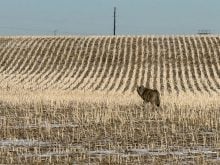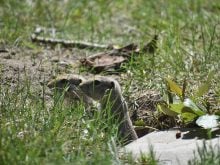Cattle producers in northern Alberta are awaiting autopsy results from a cow after two herds of cattle returned home from pasture with deformities and joint ailments.
“The cattle came home looking like they swallowed a basketball and it got stuck in their throat,” said cattle producer Susan Janzen about the large brisket edemas on the animals.
One cow, which was later put down, had basketball-sized lumps on its
udder, joints and on the brisket, said Janzen of Hythe, Alta.
So far there are no clues to what caused the problems in Janzen’s 15 animals and her neighbour Dan Cargill’s herd of 50.
Read Also

Agritechnica Day 3: Hybrid drive for a combine, data standards keep up to tech change and tractors of the year
Agritechnica 2025 Day 3: Hybrid drive for a combine, data standards keep up to tech change and tractors of the year.
“They don’t know what it was, what caused it or where it went,” said Janzen. “If it can do this to an 1,800 pound cow, I have some serious concerns about what it would do to people.”
Originally the problems were thought to be caused by the cattle drinking from the Beaverlodge River where both herds get their water.
Subsequent tests by Alberta Environment have ruled out any problems with the river water. Neighbouring horse and cattle herds that also drink from the river seem to be unaffected.
“Everything is normal. There are no concerns with the river,” said Lisa Grotkowki, public affairs officer with Alberta Environment.
Grotkowski said the department has asked people not to use water from the river as a precaution.
Alberta Environment staff have also searched the pastures where the two herds grazed. Staff members looked for poisonous plants or other possible toxins that could have affected the herds.
“It really looks like they’ve been injected with some kind of toxin or poison,” said producer Dan Cargill, who is flummoxed by the situation.
“Until we get some facts, we don’t know how to treat these animals, or if we can do something,” said Cargill.
He is not convinced by water test results.
“We keep coming back to the water.”
He is sickened each time he looks at his cattle.
“They’re really losing body condition,” he said, adding that he plans to pregnancy check each animal to see if they are still carrying calves.
“We don’t know what we’re dealing with and it scares the hell out of me.”
Darren Ludbrook, a veterinarian with West County Animal Clinic in Beaverlodge, is also confused about the cause of the fluid build up on different parts of the animals’ bodies.
Initial blood tests from some of the animals showed nothing unusual, but Ludbrook is hoping autopsy results from the worst-affected cow will help solve the mystery.
During the autopsy, he saw an enlarged heart and large accumulations of fluid in the animal’s body. Those symptoms are consistent with exposure to many common toxins.
“It’s so unreal to have that many animals affected by something we can’t identify,” said Ludbrook.
“We’re hoping by investigating her we can find something and can extrapolate it to the other animals.”














